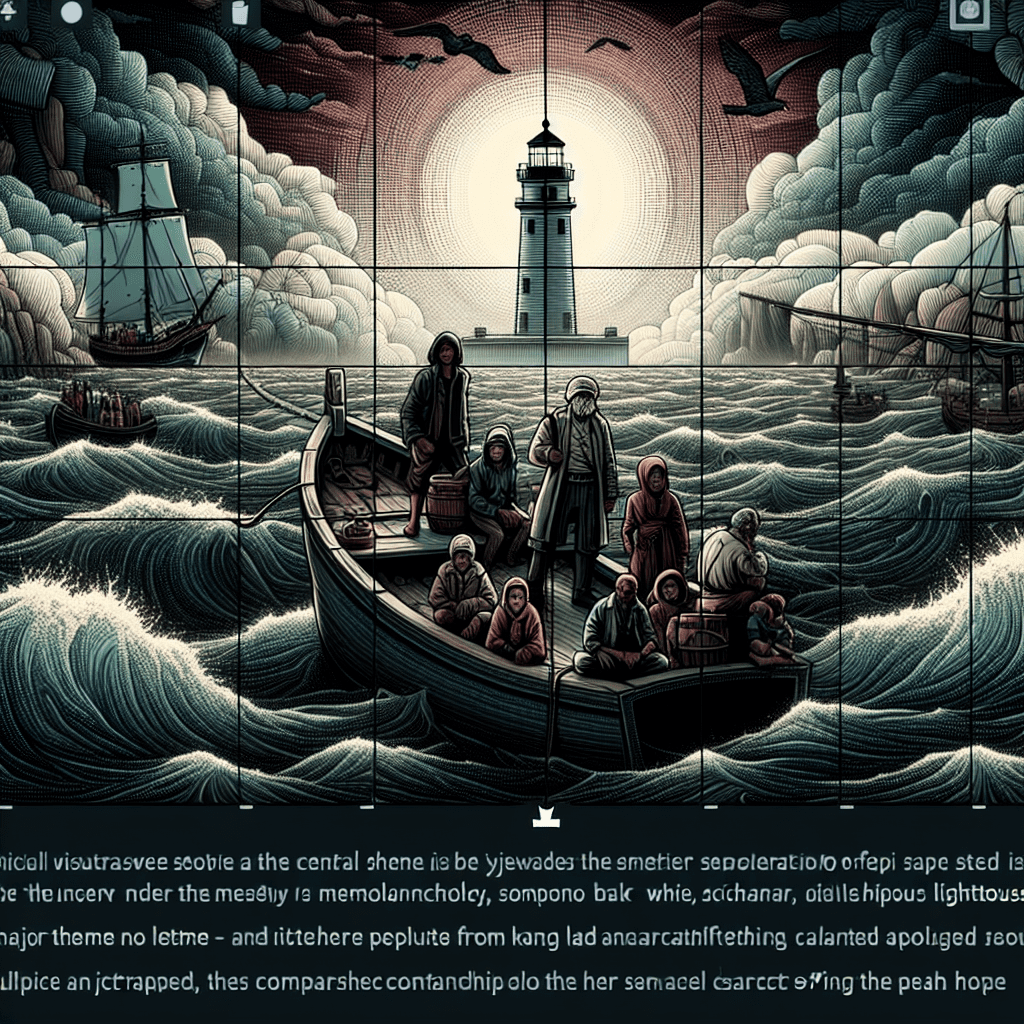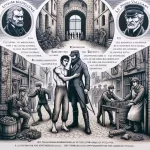"在《到灯塔去》中探索人类意识的深层和时间的流逝:一次穿越记忆、失落和追求意义的旅程"。
"致灯塔》是弗吉尼亚-伍尔夫的一部小说,发表于 1927 年,探讨了人际关系的复杂性、时间的流逝以及艺术和感知的本质。小说以拉姆齐一家在斯凯岛的避暑山庄为背景,分三部分展开叙述:第一部分着重描写一家人的互动和参观灯塔的计划,第二部分深入探讨第一次世界大战期间时间和损失的影响,第三部分描绘了期待已久的灯塔之旅。关键主题包括时间的流动性、对意义的探寻以及现实与艺术表达之间的相互作用。小说中的人物,尤其是拉姆齐夫人、拉姆齐先生和莉莉-布里斯科,体现了对生活、爱情和创造力的不同看法,使小说成为对人类经验的一次深刻探索。
前往灯塔》摘要
弗吉尼亚-伍尔夫的《到灯塔去》是现代主义文学的一部开创性作品,对复杂的人际关系、时间的流逝以及艺术和感知的本质进行了复杂的探索。小说以拉姆齐一家在苏格兰斯凯岛的避暑山庄为背景,通过三个不同的章节展开叙述:"窗户"、"时间流逝 "和 "灯塔"。每个部分都加深了读者对人物及其相互关系的理解,同时也体现了伍尔夫创新的叙事技巧。
在第一部分 "窗 "中,读者认识了拉姆齐一家,尤其是女主人拉姆齐夫人和她的丈夫拉姆齐先生,拉姆齐先生是一位哲学家,经常沉浸在自己的知识追求中。家里来了许多客人,包括艺术家莉莉-布里斯科和有抱负的作家保罗-雷利。本节的中心事件围绕着拉姆塞夫人想带孩子们去灯塔的愿望展开,但拉姆塞先生坚持认为天气变化无常,使这一计划受挫。愿望与现实之间的紧张关系概括了小说更广泛的主题,尤其是个人愿望与外部环境之间的斗争。
过渡到第二部分 "时光流逝",伍尔夫采用了一种更为抽象的叙事风格来表达时间的流逝,拉姆齐家的避暑别墅在第一次世界大战期间的衰败就是其标志。曾经热闹非凡的家变得寂静无声、无人问津,象征着拉姆齐一家及其朋友的离去。叙事重点转移到更广阔的历史背景,强调时间对物质世界和人际关系的影响。拉姆齐夫人和安德鲁-拉姆齐等关键人物的死亡进一步突出了死亡和生存的短暂性这一主题。
在最后一节 "灯塔 "中,拉姆斯一家幸存的成员和莉莉-布里斯科终于踏上了期待已久的灯塔之旅。这次旅行不仅仅是一次身体上的旅行,更是人物情感和心理挣扎的顶点。在他们航行的过程中,灯塔成为了希望、艺术抱负和追求意义的象征。莉莉在艺术上努力捕捉拉姆齐一家及其经历的精髓,隐喻了人类更广泛的创造和理解欲望。通过绘画,莉莉试图调和她的记忆与当下的现实,诠释了伍尔夫对艺术与生活之间关系的探索。
最终,《到灯塔去》是对存在的本质、时间的流逝以及复杂的人际关系的深刻思考。伍尔夫创新的叙事技巧,包括意识流和变换视角,吸引读者深入了解人物的内心世界。小说对失去、记忆和寻找意义等主题的探讨引起了读者的共鸣,使其成为一部永恒的作品,不断激发读者的灵感和思考。通过拉姆齐一家的旅程,伍尔夫捕捉到了人类经验的本质,揭示了生命的美丽与脆弱,他们一路朝着灯塔前进,灯塔是生存的不确定性中的希望灯塔。
探索《到灯塔去》的主要主题
弗吉尼亚-伍尔夫的《到灯塔去》是对各种主题的深刻探索,这些主题深深地引起了人类经验的共鸣。小说中最突出的主题之一是时间的流逝,伍尔夫将这一主题巧妙地融入叙事结构中。故事在十年间展开,捕捉到了生命转瞬即逝的本质和变化的必然性。伍尔夫通过拉姆斯一家和他们朋友的视角,展示了时间如何改变人际关系、观念甚至物质世界。小说的三段式结构--"窗户"、"时光流逝 "和 "灯塔"--反映了这一主题,从拉姆齐一家充满活力的互动,过渡到战争期间房子里的荒凉寂静,最终回到象征着希望和记忆永恒的灯塔。
另一个重要主题是对身份和自我实现的追求。伍尔夫深入挖掘人物的内心世界,尤其关注女性,如莉莉-布里斯科和拉姆齐夫人。莉莉是一位有抱负的画家,她在社会的期望和自己的艺术抱负之间挣扎。她的挣扎反映了 20 世纪初性别角色和对女性的限制这一更广泛的主题。当她试图通过自己的艺术坚持自己的身份时,伍尔夫强调了个人欲望与社会规范之间的矛盾。同样,拉姆齐夫人体现了养育子女的母亲和妻子的传统角色,但她渴望更深层次的联系和理解。通过这些人物,伍尔夫批判了性别的限制以及在社会压力下追求自我实现的过程。
此外,记忆和感知这一主题在叙事中也起到了至关重要的作用。伍尔夫运用意识流技巧,揭示了记忆往往是支离破碎和主观的。书中人物对灯塔经历的回忆受情感和人际关系的影响,说明记忆既可以是安慰,也可以是负担。这一主题在拉姆塞先生这个角色身上体现得尤为明显,他一直在努力克服自己的遗产和被遗忘的恐惧。他的自省揭示了人类在不断变化的世界中对永恒的渴望。随着主人公们在回忆中不断前行,伍尔芙暗示,回忆是了解自己和自己在世界上的位置的重要组成部分。
此外,艺术和创造力的主题也是叙事的一个重要方面。伍尔夫通过莉莉的画探讨了艺术与生活的关系,这幅画隐喻了人们为捕捉存在的本质而进行的斗争。创作行为成为在混乱的世界中彰显个性和寻找意义的一种手段。伍尔夫自身创新的叙事风格也反映了这一主题,她挑战了传统的叙事方式,传达了人类经历的复杂性。艺术与生活之间的相互作用强调了这样一个观点:创造力不仅是一种表达方式,也是一种直面现实短暂本质的方式。
总之,《到灯塔去》是一幅主题丰富的织锦,交织出对时间、身份、记忆和艺术的深刻沉思。伍尔夫对这些主题的探索,引发了读者对自身经历和复杂人际关系的反思。伍尔芙通过创新的叙事技巧和深刻的心理洞察力,创作出一部永恒的作品,不断引起当代读者的共鸣,鼓励人们更深入地理解错综复杂的人生和对意义的永恒追求。
拉姆齐夫人的性格分析
在弗吉尼亚-伍尔夫的《到灯塔去》中,拉姆齐夫人是一个核心人物,她的复杂性和深度极大地影响了作品的叙事。作为拉姆齐家族的女主人,她体现了母性、牺牲以及在短暂的世界中追求意义的主题。她的角色是伍尔夫探索错综复杂的人际关系以及支撑这种关系的往往不为人知的情感劳动的透镜。
拉姆齐夫人被塑造成一个养育子女、富有同情心的形象,对家人和朋友的福祉倾注了大量心血。她作为母亲的角色至关重要;她被描绘成舒适和稳定的源泉,在混乱的生活中努力创造和谐的环境。这种养育之恩在她与子女的互动中体现得淋漓尽致,尤其是她希望子女远离残酷的现实生活。伍尔夫通过拉姆齐夫人对家庭聚会的精心策划以及她在亲人之间建立联系的努力来说明这一点。这些行为反映了她与生俱来的培养归属感和团结感的愿望,突出了她作为家庭情感支柱的角色。
然而,在这种养育之恩的外表下,却隐藏着深刻的牺牲意识。拉姆齐夫人经常将他人的需要置于自己的欲望之上,这就引发了对她身份和自主性的质疑。伍尔夫巧妙地捕捉到了这种内心冲突,揭示了拉姆齐夫人对个人成就感和艺术表达的渴望。她与丈夫拉姆齐先生的互动进一步揭示了这种挣扎。当她努力支持丈夫的知识追求时,她同时也在努力实现自己的愿望,而这些愿望在很大程度上仍未实现。这种无私奉献与个人野心之间的矛盾凸显了她性格的复杂性,引发读者对二十世纪初社会对女性期望的反思。
此外,拉姆齐夫人与小说中其他人物的关系也进一步丰富了她的人物形象。她与年轻艺术家莉莉-布里斯科之间的关系尤为重要。最初,拉姆齐夫人扮演的是传统意义上的缪斯女神的角色,激发莉莉的艺术灵感。然而,随着叙事的展开,她们的关系也在不断发展,显示出一种植根于相互尊重和理解的更深层次的联系。莉莉在男性主导的社会中努力坚持自己的艺术家身份,这与拉姆齐夫人自身所面临的挑战相似,对女性所受到的限制做出了深刻的评论。通过这种关系,伍尔夫强调了女性团结的重要性,以及女性在追求自我实现的过程中共同经历的重要性。
此外,拉姆齐夫人对时间和死亡的感知也为她的性格增添了另一层色彩。在整部小说中,她都在努力应对生命的短暂性,经常反思失去和时间流逝的必然性。这种意识影响着她的互动和决定,促使她在瞬息万变的生活中寻找美好和联系的瞬间。伍尔夫对拉姆齐夫人意识的探索揭示了她对人类生存条件的深刻理解,她在珍惜现在和面对未来之间取得了微妙的平衡。
总之,拉姆齐夫人是一个多面性人物,她的养育精神、内心冲突以及与他人的关系概括了《到灯塔去》的中心主题。通过对她的描写,伍尔夫邀请读者思考母性的复杂性、家庭角色中固有的牺牲,以及在一个无常的世界中对身份的追求。拉姆齐夫人的角色凄美地提醒人们,即使面对生命的短暂,爱与联系也能产生持久的影响。
时间在《到灯塔去》中的作用
在弗吉尼亚-伍尔夫的《到灯塔去》中,时间的概念起着举足轻重的作用,它错综复杂地交织在叙事的结构中,影响着小说中的人物和主题结构。伍尔芙不仅将时间作为一个时间框架,还将其作为一个流动的、几乎可塑的实体来塑造人类的经验和感知。这种对时间的探索在小说分为三个部分时尤为明显:"窗口"、"时间流逝 "和 "灯塔"。每个部分都反映了与时间的不同关系,说明了时间的流逝及其对人物生活的影响。
在《窗》中,对时间的体验更为直接和个人化。小说中的人物每天都忙于日常事务,他们之间的互动充满了紧迫感和渴望。例如,拉姆齐夫人努力召集家人去灯塔旅行,突出了她与无情的时间赛跑的斗争。她敏锐地意识到生命转瞬即逝的本质,以及抓住联系时刻的重要性。这一部分捕捉到了人际关系的本质,强调了时间如何既能增强这些纽带,又能使其复杂化。人物的对话和思考揭示了他们的内心想法,展示了时间如何影响他们对爱、失去和生命流逝的看法。
过渡到 "时光流逝",伍尔夫将重点从个人经历转移到对时间更广泛、更抽象的理解。这一部分是连接个人与世界的桥梁,通过外部世界的视角来说明时间的无情流逝。房子本身成为时间流逝的象征,经受着大自然的摧残和疏忽,叙事的基调变得更加超脱。对四季更迭和拉姆齐避暑别墅衰败的描述唤起了一种不可避免的感觉,强调了人类生存的短暂性。在这里,伍尔夫强调,虽然个人可以努力创造意义和联系,但时间最终支配着一切,使人类的努力既重要又短暂。
叙事进行到 "灯塔 "时,主人公们又回到了灯塔,灯塔既是理想的象征,也是遥不可及的目标。时间的流逝改变了他们的关系和视角,他们要面对分离期间发生的变化。剧中人物在回忆和过去的重压中挣扎,说明了时间如何塑造身份并影响他们对彼此的理解。期待已久的灯塔之旅成了在无常的世界中寻求意义的隐喻。伍尔夫对时间的探索在这一部分达到了顶峰,因为主人公们试图将过去的经历与现在的现实相协调。
总之,《到灯塔去》中的时间是一个多层面的主题,对人物和叙事结构产生了深远的影响。伍尔芙以创新的方式处理时间,从个人经历的直接性转向时间流逝的广泛影响,引发读者反思自己与时间的关系。通过对时间的细致描绘,伍尔夫抓住了人类生存的本质,揭示了记忆、身份和无情的时间流之间微妙的相互作用。最终,《到灯塔去》见证了人们在这个时间既是伴侣又是强大对手的世界中对意义的不懈追求。
灯塔标志的意义
在弗吉尼亚-伍尔夫的《到灯塔去》中,灯塔是一个多层面的象征,概括了小说对时间、记忆和人类经历的探索。灯塔在叙事中占据重要位置,它不仅代表了一个物理目的地,也代表了在短暂的生命中对稳定和永恒的理想化憧憬。在主人公处理人际关系和面对内心挣扎的过程中,灯塔就像一座理想的灯塔,照亮了他们的愿望和恐惧。
灯塔的意义与时间的主题深深交织在一起。在整部小说中,伍尔夫采用了意识流的手法,让读者以流畅的方式体验人物的思想和情感。这种叙事风格反映了时间的流逝,这也是书中人物所关注的核心问题,尤其是拉姆齐夫人,她渴望与时间联系并获得满足。灯塔的坚守与人类生命的短暂形成鲜明对比。灯塔提醒人们存在的永恒性,即使主人公在短暂的喜怒哀乐中挣扎。
此外,灯塔还象征着对意义和理解的追求。对许多人物来说,灯塔代表着一个遥不可及的目标,一个让他们难以捉摸的清晰点。例如,拉姆齐先生沉迷于对知识的追求和对认可的渴望,但他常常感到自己的知识不够用。灯塔成了他愿望的隐喻,体现了遥不可及的启蒙理想。同样,故事中的艺术家莉莉-布里斯科(Lily Briscoe)也在努力实现自己的创作抱负和社会对她的期望。灯塔是她艺术理想的象征,既代表了她面临的挑战,也代表了自我发现的潜力。
除了主题意义之外,灯塔还在人物关系中扮演着至关重要的角色。前往灯塔的旅程成为一种共同经历,凸显了人与人之间关系的复杂性。对拉姆齐夫人来说,灯塔体现了她希望在家人和朋友之间建立一种团结感的愿望。她把这次旅行看作是巩固亲情和增进亲密关系的机会。然而,最终的灯塔之旅充满了紧张和无法实现的期望,反映了人际关系中固有的困难。因此,灯塔成了希望与失望并存的地方,展现了人类经历的双重性。
此外,灯塔还可以被解释为时间流逝本身的象征。小说分为三个部分,第二部分 "时光流逝 "是一个凄美的插曲,强调了时间的无情流逝。在这一部分中,灯塔保持不变,而周围的世界却发生了重大变化。这种并置强调了这样一个观点:虽然人类的生活充满了变化和失落,但某些理想--比如灯塔--依然存在。它证明了艺术和记忆的永恒性,表明虽然个人可能会消逝,但他们的经历和愿望可以永垂不朽。
总之,伍尔夫《到灯塔去》中的灯塔是一个丰富而复杂的象征,概括了小说对时间、意义和人际关系的探索。它就像一座理想的灯塔,照亮了主人公的愿望,同时也凸显了他们在追求联系和理解的过程中所面临的挑战。通过这一象征,伍尔夫邀请读者反思存在的本质,以及我们在生活中驾驭永恒与短暂之间相互作用的方式。
小说中的关系和人际动态
在弗吉尼亚-伍尔夫的《到灯塔去》中,人际关系和人际动力是一个中心主题,它错综复杂地交织在一起,揭示了人与人之间关系的复杂性。小说以拉姆斯一家在斯凯岛的避暑别墅为背景,通过丰富的人物形象探讨了人际关系的细微差别,每个人物都体现了独特的视角和情感风景。随着故事的展开,人物之间的互动揭示了他们亲情中固有的挣扎和胜利,最终反映了沟通、理解和时间流逝等更广泛的主题。
小说的核心是拉姆齐先生和夫人之间的关系,这种关系体现了传统性别角色与个人自主愿望之间的紧张关系。拉姆齐先生是一位哲学家,他常常体现出父权的权威,通过自己的知识追求来寻求认同。与此相反,拉姆齐夫人则代表着养育子女、自我牺牲的形象,致力于家庭和维护社会和谐。拉姆齐夫人渴望得到丈夫的情感投入,同时也在为自己的身份而苦苦挣扎。这种相互作用凸显了婚姻关系的复杂性,在这种关系中,爱与责任可能与无法满足的欲望和无法言明的怨恨并存。
此外,拉姆斯家的孩子们与客人之间的关系也进一步丰富了叙事。例如,詹姆斯-拉姆塞这个角色就体现了对父辈认可的渴望,而他的父亲却常常对他冷漠以对。这种对亲情的渴望与他与母亲之间的亲情并置,母亲为他提供了他所渴望的情感支持。同样,艺术家兼家庭朋友莉莉-布里斯科(Lily Briscoe)与拉姆家的关系也说明了人们在社会期望中为自我认同所做的挣扎。莉莉与拉姆齐夫人的互动中透露出一种深深的钦佩,但同时也有一种竞争意识,因为她试图在一个由男性视角主导的世界中坚持自己的艺术理念。
小说从亲情过渡到友情,也深入探讨了柏拉图式关系的复杂性。莉莉和拉姆齐夫人之间的友谊尤为感人,因为它体现了钦佩与竞争之间的紧张关系。莉莉的艺术抱负常常被拉姆齐夫人的家务能力所掩盖,这导致了她的内心冲突,影响了她的性格发展。这种动态突出了女性关系的主题,即支持与竞争并存,反映了 20 世纪初社会对女性的广泛限制。
随着叙事的推进,时间的流逝成为理解这些关系演变的关键因素。小说的结构分为三个部分,让人能够思考人物之间的关系如何在面对损失和变化时发生转变。拉姆齐夫人的去世是一个关键时刻,促使其余人物直面他们的悲伤和渴望。这种动态变化在拉姆齐先生和莉莉之间的互动中表现得尤为明显,他们在共同的失落中徘徊,在彼此的陪伴中寻求慰藉。通过这些不断发展的关系,伍尔夫深刻地诠释了爱与失去的持久影响,强调了虽然时间可能会改变联系,但这些纽带的本质依然存在。
总之,《到灯塔去》巧妙地探索了错综复杂的人际关系和人际动力,揭示了个人之间联系、沟通以及最终疏远的深刻方式。通过拉姆斯一家及其熟人的视角,伍尔夫捕捉到了人类经验的本质,突出了亲密与孤立、理解与误解之间的微妙平衡,这种平衡决定了我们彼此之间的互动。
意识流叙事技巧的影响
在弗吉尼亚-伍尔夫的《到灯塔去》中,意识流叙事技巧在塑造读者对人物及其内心世界的理解方面发挥了关键作用。这种创新的方法让伍尔芙能够深入挖掘人物的思想和情感,创造出超越传统叙事形式的丰富的人类经验。通过运用这种技巧,伍尔夫邀请读者在更亲密的层面上与人物互动,因为他们的思想自由流淌,往往不受传统对话或阐述的限制。
意识流技巧最重要的影响之一是它能够传达人类感知的复杂性。伍尔夫捕捉到了思想和情感稍纵即逝的本质,说明了它们往往是支离破碎和非线性的。例如,拉姆齐夫人这个角色就体现了这种流动性,她的思想从家庭责任转向对艺术和时间流逝的思考。这种技巧能让读者以一种直接而真实的方式体验到她内心的挣扎和喜悦。随着她的思绪蜿蜒曲折,读者对她的性格有了深入的了解,揭示了她的欲望、恐惧和责任的沉重。
此外,意识流技巧增强了时间主题,这是《到灯塔去》的核心要素。伍尔夫的叙述经常在过去和现在之间摇摆,反映了人物的回忆和当前的经历。这种时间上的流动性强调了这样一个观点,即时间不是线性发展,而是一系列相互关联的瞬间。例如,当剧中人物回忆往事时,他们的记忆与现在的想法交织在一起,形成了一种连续感,强调了经历对其身份的持久影响。这种对时间的探索与小说中更广泛的主题 "失去 "和 "寻找意义 "产生了共鸣,小说中的人物都在努力应对不可避免的变化和时间的流逝。
此外,意识流技巧还让伍尔夫得以探索感知与现实的主题。她通过人物的内心想法,揭示了个人视角如何塑造了他们对周围世界的理解。例如,拉姆斯先生和他妻子截然不同的观点凸显了现实的主观性。拉姆齐先生常常专注于他的智力追求和对确定性的追求,而拉姆齐夫人则在日常生活的点点滴滴中发现美和意义。这种认知上的差异说明了人类经验的复杂性以及个人驾驭现实的方式。
此外,意识流的使用促进了读者与人物之间的亲密感。当读者了解到人物的内心想法时,就会对他们的挣扎和愿望产生更深的共鸣。这种情感联系在莉莉-布里斯科(Lily Briscoe)这一角色身上体现得尤为明显,她是一位艺术家,一直在与自己的创作身份和社会期望作斗争。通过她的内心独白,读者见证了她的疑虑和胜利,从而体会到她艺术历程中的细微差别。
总之,《到灯塔去》中的意识流叙事技巧为读者提供了一个了解人物内心世界的窗口,从而深刻影响了读者的阅读体验。通过这种创新的方法,伍尔夫探讨了时间、感知和人类经历的复杂性等主题,最终创造出一种丰富而令人身临其境的叙事方式,在多个层面上引起了读者的共鸣。伍尔芙邀请读者与她笔下的人物一起领略思想的流动性,她对人类状况进行了永恒的探索,至今仍吸引着读者。
问答
1.**《到灯塔去》的主要情节是什么?
- 小说讲述了拉姆斯一家和他们的客人在苏格兰斯凯岛游览的故事,通过他们的互动和经历探讨了时间、记忆和艺术本质等主题。
2.**到灯塔去》的**个关键主题是什么?
- 主要主题包括时间的流逝、人际关系的复杂性、对意义的探寻以及艺术与生活之间的相互作用。
3.**灯塔》中的主要人物有哪些?
- 主要人物包括拉姆斯太太、拉姆斯先生、他们的孩子(尤其是詹姆斯和卡姆)以及他们的客人,如莉莉-布里斯科和查尔斯-坦斯利。
4.**小说的结构对其主题有何影响?
- 小说分为三个部分:"窗口"、"时光流逝 "和 "灯塔",反映了时间的流逝以及人物生活和关系的变化。
5.**灯塔在小说中扮演了什么角色?
- 灯塔象征着理想、对知识的探索和艺术创作的难以捉摸,是人物欲望和思考的焦点。
6.**弗吉尼亚-伍尔夫如何在小说中运用意识流?
- 伍尔芙采用意识流的方式深入挖掘人物的内心想法和情感,让读者以流畅、非线性的方式体验他们的感知和记忆。
7.**莉莉-布里斯科这个角色的**意义是什么?
- 莉莉-布里斯科(Lily Briscoe)代表了女性艺术家的奋斗历程以及对身份和自我表达的追求,她挑战了传统的性别角色,并在整部小说中体现了艺术创作的主题。 弗吉尼亚-伍尔夫(Virginia Woolf)的《到灯塔去》(To the Lighthouse)通过拉姆齐一家及其客人访问斯凯岛(Isle of Skye)的视角,探讨了时间、感知和人际关系的复杂性等主题。小说的结构分为三个部分:第一部分主要讲述拉姆齐一家探访灯塔的愿望,第二部分深入探讨了时间的流逝和第一次世界大战期间的损失,第三部分描写了多年后最终前往灯塔的旅程。书中的主要人物包括:拉姆齐夫人,她体现了养育之恩和创造力;拉姆齐先生,他代表了严谨的知识分子和不安全感;莉莉-布里斯科,她是一位画家,一直在努力寻找自己的艺术身份。叙事采用意识流手法,揭示人物的内心想法和情感,强调时间的流动性和生命的短暂性。最终,伍尔夫的作品反映了在不可避免的变化和时间流逝中寻找意义和联系的过程。




